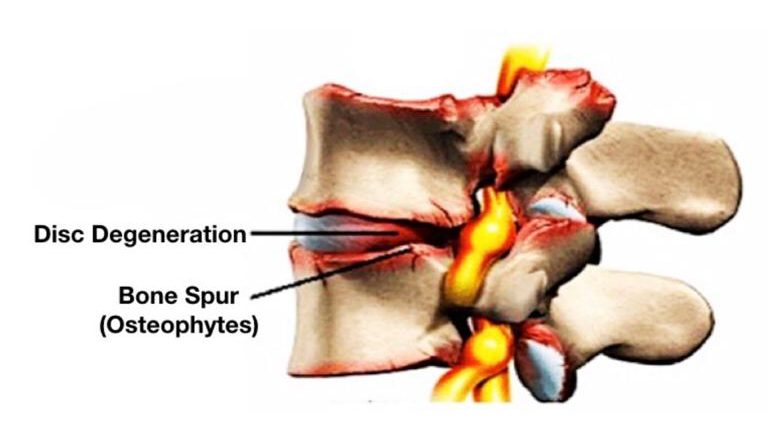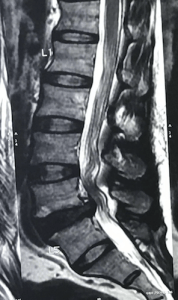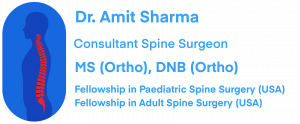Lumbar Spondylosis
Lumbar Disc Degeneration: Symptoms, Diagnosis and Treatment
When it comes to spine health, lumbar spondylosis is a condition that deserves our attention. This common ailment can affect individuals of all ages and backgrounds, leading to discomfort and reduced quality of life. In this comprehensive guide, we’ll explore lumbar spondylosis, its symptoms, treatment options, and strategies for prevention.
Spondylosis means arthritis of vertebral joints (disc and facets). The term Spondylosis is commonly used to refer Cervical Spondylosis; however, it affects other parts of the spine also (Thoracic Spondylosis, Lumbar Spondylosis). The cause of pain is similar to knee arthritis. As disc degenerates, it loses its capability as shock absorber. Similarly, facet joints get rough due to loss of smooth cartilage on its surface. These factors cause significant friction between adjacent bone surfaces leading to pain in the local area. Frequently, lumbar spondylosis is accompanied by spinal stenosis of varying degrees.
Primary cause of lumbar spondylosis is age related degeneration (chronic wear and tear) of disc and facet joints. It primarily affects elderly patients. Obese individuals and people with poor lifestyle (wrong posture, long sitting, inactivity) are more prone to develop these degenerative changes. Occasionally, acute injury and accident also can lead to spondylosis at a younger age.


Lumbar Spondylosis Symptoms:
Typical symptoms of spondylosis is pain in the local area. Pain may also radiates to nearby areas like buttock area, posterior thigh depending upon the site of arthritis. If there is associated slip disc or spinal canal stenosis, patient may also have neurological symptoms (pain in legs, tingling-numbness, loss of sensation, weakness etc.).
1. Lower Back Pain: The hallmark symptom of lumbar spondylosis is lower back pain. This pain can range from mild to severe and may be persistent or intermittent.
2. Stiffness: Many individuals with lumbar spondylosis experience stiffness in the lower back, especially after periods of inactivity.
3. Reduced Range of Motion: Lumbar spondylosis can limit your ability to move your lower back comfortably, making everyday activities challenging.
Lumbar Spondylosis Diagnosis:
Spondylosis is primarily diagnosed by history of local pain in spinal area. In addition following tests can be done:
- X-ray: An x-ray will show loss of disc height, indicating thinning of disc material. X-ray will also show any spine deformity, spine fracture. An x-ray in different positions (flexion-extension) will reveal any associated spinal instability, which might be missed on static imaging, like MRI.
- MRI Scan: It will show loss of water content of disc material (disc desiccation), arthritis of facet joints and associated spinal stenosis.
- CT Scan: to assess bony anatomy in detail.
- Other tests, like EMG-NCV, blood tests etc, might be required to confirm or rule out any associated pathology.
Lumbar Spondylosis Treatment:
- Medical Treatment: Like any other spine condition, initial treatment of spondylosis is primarily by medicines, local heat/ ice, bracing, activity restriction and physiotherapy. Physiotherapy helps build muscle strength and relieves muscle spasm. Stronger muscle will act as internal brace and will prevent excessive motion at painful spinal segment.
- Pain Management: There are various procedures targeting disc (intra-discal steroid injection, LASER disc therapy), facet joint (facet injection, Radio-Frequency nerve ablation) or the spinal cord (root block/ epidural injection). These procedures are done to provide pain relief. They do not reverse degenerative changes in spine.
- Spine Fusion/ Instrumentation Surgery: Primary reason of pain in spondylosis is friction of arthritic surfaces. Spine instrumentation aims at eliminating this painful motion. Bone fusion is usually done along with spine instrumentation for long term success of the surgery. Various spine instrumentation/ fusion devices are available. A specific procedure is chosen based on patient’s pathology and spine specialist’s preference. Most of the spine fusion surgeries can be done now with minimally invasive/ key hole techniques. A decompression procedure is usually done simultaneously with spine fusion surgeries. Extent of spine decompression will depend on amount of spinal stenosis.
- Disc Replacement Surgery: One of the drawback of spine fusion surgery is loss of movements at operated level. This leads to certain movement restrictions to the patients. Also, after spine fusion there is increased stress on adjacent vertebral motion segments due to distribution of lost movements at operated level. This might lead to accelerated degeneration of adjacent disc/ facet joints (called Adjacent Segment Degeneration in medical terms). To prevent these, disc replacement can be done which maintains movements at operated level also. Disc replacement is not very successful for lumbar spine due to excessive stress at these levels. As only disc is replaced in disc replacement surgery, if there is associated facet arthritis, pain relief will not be adequate as pain from facet joints will persist. For patients with advanced arthritis, spine fusion will give more predictive results.
Preventing Lumbar Spondylosis
While lumbar spondylosis is often associated with aging, there are steps you can take to reduce your risk:
1. Maintain a Healthy Weight: Excess weight can place added stress on the spine. Maintaining a healthy weight through diet and exercise can help reduce this risk.
2. Stay Active: Regular physical activity, including exercises that strengthen the core and lower back, can help keep your spine healthy.
3. Proper Posture: Maintaining good posture, both while sitting and standing, can reduce strain on the lower back.
4. Avoid Smoking: Smoking can contribute to disc degeneration, so quitting smoking can benefit your spinal health.
5. Ergonomics: Proper ergonomics in the workplace and at home can reduce the risk of developing lumbar spondylosis.
Finding the Best Lumbar Spondylosis Specialist in Mumbai
If you’re in Mumbai and seeking expert guidance and treatment for lumbar spondylosis, it’s essential to choose the right specialist. Look for a healthcare provider with expertise in spine health and a focus on patient-centered care.
Take Charge of Your Spinal Health
Lumbar spondylosis may be a common condition, but it doesn’t have to control your life. With the right information, treatment, and preventive measures, you can take charge of your spinal health and enjoy a pain-free, active life.
For more information on lumbar spondylosis or to consult with a leading spine specialist in Mumbai, contact Dr. Amit Sharma today on +91-9967600461 or draks777@gmail.com
